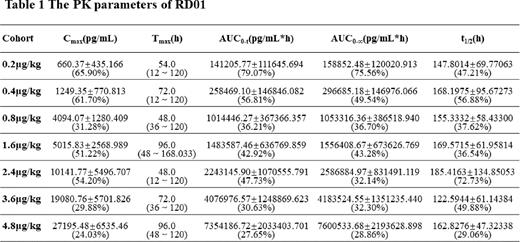Abstract
Background: Polyethylene glycol-erythropoietin injection, also called RD01, is pegylated recombinant human epoetin alfa (rHuEPOα) which stimulates erythropoietin receptors on erythroid progenitor cells to induce the formation of new red blood cells. rHuEPO (both α and ꞵ, which are almost identical to endogenous erythropoietin in the sequence of amino acids, but are distinct in their glycosylation pattern) have short half-life in 6 to 24 hours after intravenous (IV) or subcutaneous (SC) injection (Halstenson 1991; Salmonson 1990), Darbepoetin alfa, which is more highly glycosylated epoetin and has a longer half-life in 24 to 72 hours (Macdougall 2007; Padhi 2006) and CERA is a pegylated rHuEPO ꞵ with a comparable half-life of about 130 hours (Macdougall 2006). However the pharmacokinetics of pegylated rHuEPOα has not been reported. Here we reported the results of the first-in-human study of the safety, tolerability, and pharmacokinetics of RD01 in healthy volunteers.
Methods: In this double-blinded, placebo-controlled, dose escalation study, healthy volunteers were randomly assigned (10:2) to receive single dose of RD01 (0.2, 0.4, 0.8, 1.6, 2.4, 3.6, 4.8 μg/kg) or placebo via subcutaneous injection. There were 7 cohorts, and each cohorts consisted of 12 subjects. Study consisted of screening period (up to 14 days), treatment and assessment period (35 days), and an end-of-study visit (at day 35). RD01 pharmacokinetics parameters were estimated using non-compartmental analysis. Safety, tolerability, and immunogenicity were assessed throughout the study.
Results: All adverse events (AEs) were of mild to moderate intensity. There were no deaths, serious AEs, or withdrawal from study due to AEs. The most frequent (>5%) drug-related treatment emergent adverse events (TEAE) were serum iron decreased, serum ferritin decreased, unsaturated iron binding capacity increased, leukocyte count decreased, and diarrhea . No clinically significant findings in vital signs or electrocardiogram were observed. Positive ADA responses to RD01 were observed in 7 of 70 subjects.
The exposure (AUC0-∞) and maximum concentration (Cmax) of RD01 were approximately linear in the range of 0.2-4.8 ug/kg dose. The median Tmax was 48~96 hours, while mean t1/2 as 82.4~160.6 hours (Table 1 The PK parameters of RD01). While RD01 of 0.2- 4.8 μg/kg dose-dependently elevated hemoglobin, reticulocyte and hematocrit. In volunteers who received RD01 above 0.8 μg/kg, the mean changes from baseline of hemoglobin concentration increased over 10 g/L within 7 days after dosing. Compared with placebo, RD01 above 0.8 μg/kg also produced greater mean maximum effect (Emax) in hemoglobin, reticulocyte and hematocrit.
Conclusion: RD01 (0.2-4.8 μg/kg) was well tolerated by healthy Chinese subjects with a much longer t1/2, that supported further clinical development of RD01 (above 0.8 μg/kg) for patients with anemia.
Disclosures
No relevant conflicts of interest to declare.
Author notes
Asterisk with author names denotes non-ASH members.


This feature is available to Subscribers Only
Sign In or Create an Account Close Modal